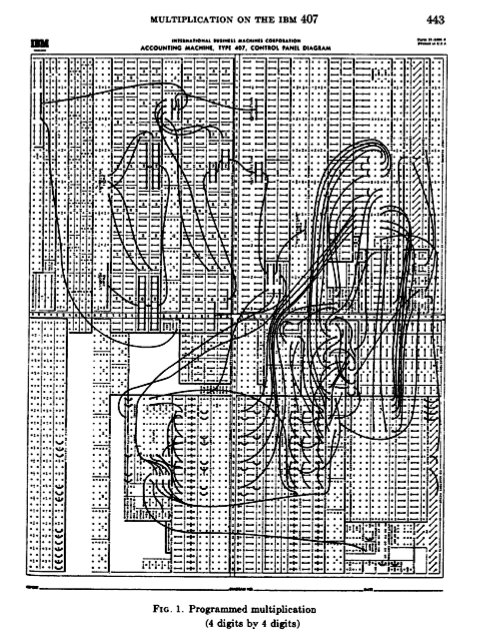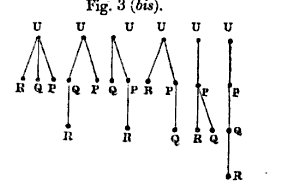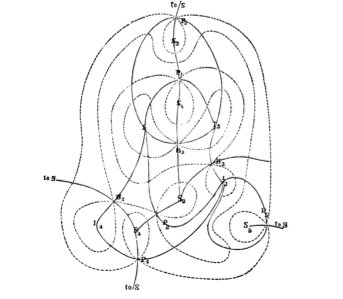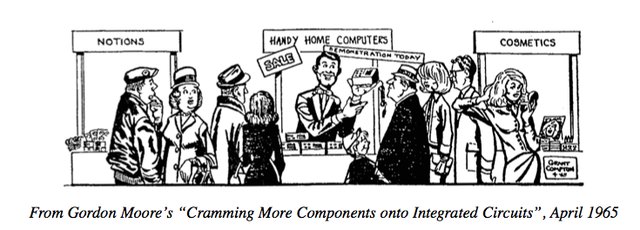"These twice five figures" with which we count are clearly related to our five fingers[0].
But why five? TIL that it's a few hundred-million-year backward compatibility issue:
Because there are only five distinct Hox-encoded domains across the limb bud there is a developmental constraint prohibiting the evolution of more than five different types of digits.
[0] at least when counting moving objects, such as cattle; bakers, whose objects tend to stay where one left them, use nicer rectangles, and hence prefer dozens to tens.
Resolving two clauses with more than one pair of complementary literals always yields tautology.
(formally, the absorption works almost identically to the well-known physical notion that ∂∂=0 "boundaries are unbounded". I have not yet learned whether there is anything more to this correspondence than the simple observation that a logical formula represents –cf Karnaugh– a "Truth polygon"...)
Aristotle's Organon roughly translates to "instrument, tool".
Was "Notation as a Tool of Thought" a conscious tip of the hat to the Stagirite?
(much less likely, but possible: was this title simply a metasyntactic variable Aristotle's students used to refer to his lecture notes? — cf fr. truc)
bis quinque figuris: (Carmen de Algorismo)

I'd always thought Landin's "Program Machine Symmetric Automata Theory" (Machine Intelligence 5) rather imaginative:
"Suppose a directed graph with coloured edges is drawn on a plane, and another one drawn on the surface of a sphere. Imagine the sphere rolling ... on the plane, but constrained in such a way that the point of contact follows ... both graphs ... synchronizing the vertices and matching the colours.
TIL that mid-XX fire control actually involved computations via rolling (albeit continuously) spheres on planes.
(to paraphrase Körner: that these have been obsoleted by digital systems probably says more about human technological than moral progress over the last several decades)
The chance that an arbitrary permutation doesn't have any fixed points tends to 1/e.
(is this any relation to the 1/e that shows up in optimal stopping heuristics?)
In the XIX, FMACs were done with springs (and clocked via handcrank):
the null program, at least by certain measures, has manifold ramifications — more than the typical filesystem.
Iron oxides are not only abundant, they globally occur on a geologic scale in large, layered "Banded Iron Formations"; what I was taught about these seems to still be the conventional wisdom, namely that they're a highly visible side effect left over from when the biosphere discovered photosynthesis.
Once upon a time, an investor related an old story about working on some government contract involving vector displays costing thousands, if you could source them at all ... and then being shocked to discover Vectrexen being sold in Sears for under USD 200. TIL that in the early 80's, game companies didn't just buy displays, they did some serious engineering to meet their price points via hw/sw codesign.
From when "spaghetti code" was meant literally: how adders could multiply (w/out logs):

Boyell, "Programmed Multiplication on the IBM 407" (1957)
The J language hashtag has a high (proper!) ratio of models to lines of source code.
(upon investigation, #JLang might have a maximal intersection of "fashion models" with "source code", not just for programming hashtags, but also —despite Amazon's best efforts at searchspam— for the web in general)
According to Hamming, the naming instance of Gibbs' phenomena was due to investigating an unexpected behavior of Michelson's mechanical fourier analyzer ... not just chalking it up to experimental error.
("The Art of Doing Science and Engineering", pp109-110)
Cayley not only introduced the term "tree" (in the CS sense) to the english language in 1857, he did so as a computer scientist:
- his motivation was abstract parses of concrete syntax
- his investigation distinguishes between commutative and associative operations, and
- his trees have their roots at the top, and their branches opening downwards!

The "Alabama Song" was originally written (in english) for a Brecht work (which was then performed in german) in the 20's, before being covered by the Doors (in english) in the 60's.
The sequence:
0 → algebra scenes → hollywood movies → profit → 0
fails to be exact at small values of "profitable":
It's My Turn (1980) Snake Lemma
The first log tables were laboriously hand calculated once, and then apparently cut'n'pasted from one application to another for the following three centuries:
all logarithm tables for three hundred years were borrowed from Mr. Briggs’ tables by reducing the number of decimal places
Today, computation is too cheap to meter and one can program the necessary calculation, even without import math, in a matter of minutes. Obtaining the patterns required to make the insights necessary to get to \mathbb{C} when given \mathbb{N} ... might take a bit longer.
# after http://www.feynmanlectures.caltech.edu/I_22.html#footnote_source_1
_=min
sqrt = lambda n: _( cvg(nstep(n1))(n1)
for n1 in [float(n)]
for cvg in [lambda f: lambda x:
_( x if y==x else cvg(f)(y)
for y in [f(x)] )]
for nstep in [lambda n: lambda g: (n/g+g)/2] )
if __name__ == "__main__":
def D(x):print(x);return x
# regenerate table 22-1 from feynman LoP
n = 10
for i in range(16): n = sqrt(D(n))
# check precision after inverting
for i in range(16): n = n*n
print(n,n - 10.)
On Hills and Dales, although published almost a century and a half ago in Philosophical Magazine is surprisingly (at least in my search engine bubble?) difficult to find in full text. Best I could do was p.233, paper XLIII in a collection of Maxwell's works.

Is there an anglophone equivalent of Gallica?
Edit: Cayley's 1859 On Contour and Slope Lines was, happily, more readily available.
TIL that not only is a « zapaska » a "stepney" in english

(thank you, Dyadya Google) but also that a "stepney" is neither cisatlantic nor translatlantic, but transpacific. (thank you Auntie Beeb).
By way of Bunnie, TIL Gordon Moore may not have predicted current fashions (and was a little pessimistic about the size of smartphones), but he definitely knew —a half century ago— how pursetop computers would be marketed:

TIL @michaelbolton is a programmer. I failed to learn, however, if he knows what "PC LOAD LETTER" means.
TIL how to trick a neural network into thinking a panda is a vulture
- (I wonder if the same principle: "it doesn't matter if it's not a vulture as long as the weights add up to vulturish" applies to "it doesn't matter if it's not journalism as long as the ad buys add up to journalistic"?)
TIL about a Cousot et Cousot paper on Galois Connections ... well, actually it's (as one might guess from the topic?) a pair of papers: one of which is the expanded concrete representation, the other of which is a compressed (albeit still containing most of the important bits) abstract representation.
The soviet-era Elbrus computer line was based on the same B5000 that many software people consider "an improvement upon nearly all its successors" (unfortunately for Burroughs' reception in the marketplace, their peripherals may not have been so reliable: worse is better, except when it isn't).
TIL the Elbrus tradename is still in commercial use, although these days it looks as if it's being slapped on systems running Linux on SPARC derivatives instead.
However, if the RF equivalent of "orange book" systems buyers still can source something with the safety properties of the old MCP lineage, it might help explain the recently infamous « русский хакер ». After all, if you live in a wooden house, with roughly capability-based security, while your neighbor's glass house is chock full of legacy x86 and C/C++, it must take an awful lot of willpower to avoid throwing stones...
In a world where Poe's Law appears to reign supreme, one can always peruse abstract comics. They have the graphical syntax of comics, but lack semantics. Might they be the grandchild of Dada?
POST TENEBRAS LVX
TIL the Republic and Canton of Geneva has a nifty motto, thanks to following the architectural references in Geneva's entry in the grand tradition of #2 videos:
"Geneva second | Genève interpelle Donald Trump"
c'est toujours le plus intelligent qui cède
TIL about the Turpan hydraulic engineering. I found it especially interesting, because just behind my house is one of our local (above-ground) canals, conducting glacial melt from the alpine valleys above to the grapes and apricots growing below.
(not from today, but...) it's not just Mexico and the US; "coca-cola" is more a brand than a specific flavor.
[Edit: ... and for people who live in sufficiently cosmopolitan parts of the US, sugar-sweetened coca-cola can be found]
Youtube: not only good for pseudorandomly encountering pop music from other cultures, but also serves as an unusually diverse mirroring medium for linux distros:
Older Siemens ES64U locomotives had sidelobes in the audio range during initial acceleration ... but someone decided this bug could be a feature, and so they played a distinct do-re-mi.
TIL Ernst Schröder would've have to wait nearly 80 years* —with the intervening invention of the computer — for his late XIX logical notation:
 (here intended as part of a universal formal "pasigraphy", as communicated to an international mathematical conference in Zürich) to find yet another application: as a simpler, if unfortunately far too earlier, alternative to predicate transformer semantics.
(here intended as part of a universal formal "pasigraphy", as communicated to an international mathematical conference in Zürich) to find yet another application: as a simpler, if unfortunately far too earlier, alternative to predicate transformer semantics.
- „Über Pasigraphie, ihren gegenwärtigen Stand und die pasigraphische Bewegung in Italien‟, 1897
Giuseppe Peano was evidently a bit jealous of Leibniz' XVII ability to publish things like:

(to express commutativity and idempotency), for even in the late XIX he expresses himself anachronistically:

(Peano's versions of his symbols make better ping-pong paddles than our modern variants!)
Evidently Peano went even further than Schröder's Pasigraphy , proposing not only the formal notation for which we remember him, but even a creolized Latin to serve as a scientific conlang for informal argument ... but he wasn't foolish enough to attempt to revive greek!
- Peano, Arithmetices Principia: nova methodo exposita (1889) p. viii
- Leibniz Addenda ad Specimen Calculi Universalis (ca. 1680) p. 1
One of the most surprising things about electronic mail is the ease with which misinterpretations arise
was a 1985 sentiment from RAND report R3283, "Toward an Ethics and Etiquette for Electronic Mail". Now I'm imagining ca. 2005 Odeo looking at email and exclaiming "hold my beer!"
